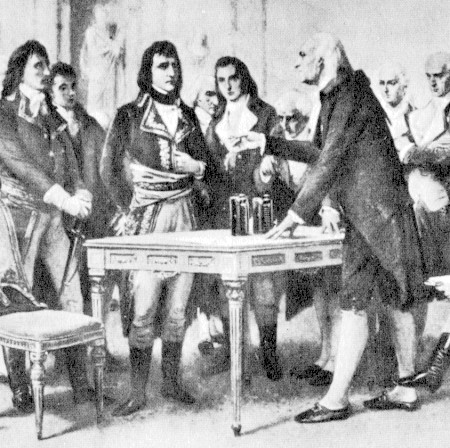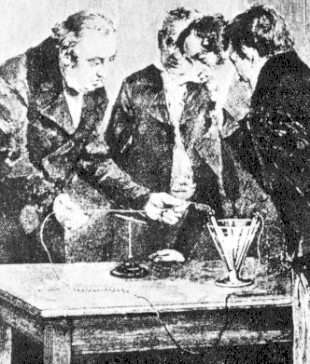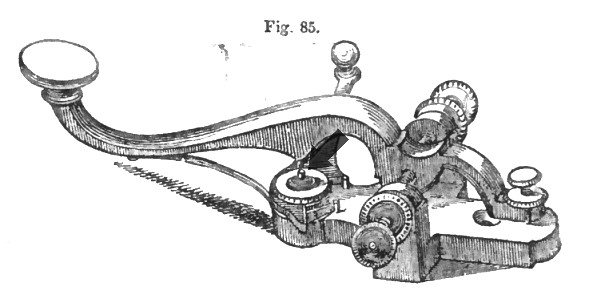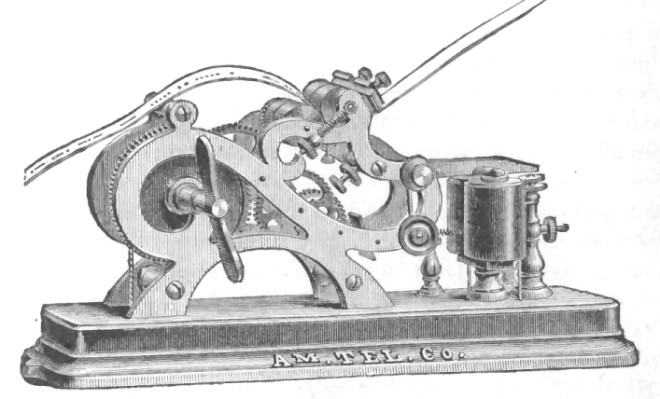The Telegraph
Part 1
1. The telegraph was invented by ...
2. The telegraph signals representing the letters of the alphabet were invented by ...
3. One of 'America's best painters in 1832' was ...
4. In St. John's, Newfoundland, Signal Hill was named for ...
5. In San Francisco, Telegraph Hill was named for ...
Before researching this page, I would have answered none of the 5 questions above correctly.

The answer to Question 3 is Samuel F.B. Morse 1791-1872 ... born in Massachusetts.
His self-portrait is shown above.
After Yale, between 1811 and 1832 Morse
spent a total of 7 years in Europe (2 visits) to study and to paint. While back in America, he was reasonably successful in the eastern US as a travelling portrait painter.
However, the cadre of people who 'needed' their portraits painted was a
shallow market which limited his ability to settle down with his
family. Morse stubbornly clung to the contemporary European idea that
only
history and antiquity were worthy of artistic
representation. Unfortunately for his future as a classical painter ... most Americans weren't at
all interested in history or antiquity.
It was a age 41 that Morse became inspired to invent the 'magnetic telegraph'.
This was based on discussions he had with some Europeans as he sailed back from France in 1832.
He had no knowledge of things electrical, his wife had died, and he had three children to support ...
To save time, insert a movie montage at this point of about 25 soundless scenes,
use peppy 'montage music' for the audio:
Scenes include:
- Morse inventing stuff that doesn't work well ...
- Morse talking to Professors Gale and then Henry ...
- Begging more technical advice and money ...
-
Painting political subjects and more portraits ...
-
His kids splashing in a bubble bath and Morse as a harried single dad ...
- Morse inventing still more stuff that doesn't work well ...
- Receiving $2000 from Stephen Vail IF Morse will employ the industrialist's son ...
- Employing Alfred Vail and his talent for invention ...
-
Vail writes the code and designs and builds the telegraph devices which work.
Final scene of the montage: Morse writes and stamps his name on everything.
Alfred Vail smiles, shrugs and pats Morse on the back.
|
The codes for common letters were short ... while rarely used letters
used the 'leftover' longer codes.
To figure this out, the shop of a professional printer was visited ...
If a metal printing slugs for a given letter (e.g. 'e') were kept in great quantity ...
that letter was assumed to be common and it received a code which was quick to send.
'e' took one 'count' to send.
If fewer slugs were kept for a given letter (e.g. 'p' and 'j') ...
then a longer code was assigned.
'p' and 'j' each took nine 'counts' to send.
Note: Some 'continental' changes were made to the code when the Germans
and other Europeans began using it ...
because when they do their 'Europe Talk' ...
like, they make different noises from us, eh?
'Who used which code when' ... is an interesting historical puzzle to solve.

Modest Alfred Vail
... neither did he expect credit for helping Beethoven with his Fifth Symphony.
Morse rushed off to England to patent his inventions there in 1837 ...
In England, Wheatstone and Cooke had already patented an electromagnetic telegraph
and it was working on a railway in the summer of 1837.
In Germany, Steinheil had invented an electromagnetic telegraph in 1837 and in the same year,
and discovered the 'earth return' while trying to use the rails of a German railway as the conductors for his telegraph.
Schilling of Russia had invented a telegraph back in 1820, and the Czar had deemed it a potentially subversive invention.
Because of the telegraph, when the Czar Nicholas I (reigned 1825-1855) died in 1855 at St. Petersburg,
the event was announced in the British House of Lords just a few hours later.
It was American university professors Leonard Gale (1800-1883) and Joseph Henry (1797-1878) named above
who had provided essential technical advice and materials which made the development of the Morse system possible.
|
The general points to consider here are ...
-
Morse was very successfully pursuing and promoting his dream ... but he was not really 'The Inventor' ...
- The diverse experiments with 'electricity' during this era were generally published and in the public domain.
-
Many scientists made a point of giving their discoveries to humanity and not patenting the apparatus they developed.
- During
this very productive era, unless you read all the latest American, British, French and
German scientific papers, you were likely to miss something.
-
The 'industry' of making little devices with cells, wires and iron had very low 'barriers to entry'.
- You can read all the accounts available today and conclude that many scientists, inventors and businessmen were simultaneously
having similar inspirations on different continents about 'the
telegraph' ... back when most information travelled on paper ... and usually at
the speed of horse and/or sail.
- Often things got nasty and legalistic over patents and
credit ... and then 'histories' were written to 'correct' the
historical record.
|
The essential American patents were owned by the 'Morse Patentees' - Morse held a 9/16 share.
The patents were valid from 1840 to 1861.
And the phrase 'What hath God wrought?' ... Morse's legendary first telegraphic words in 1844 ...
from Washington to Baltimore and repeated back by Vail
... was someone else's idea too.
If you are visiting this site via an internet connection from ancient Greece,
you will not need the following 'translation'.
tele graph = distant writing
Hand signals and signal fires
were likely the first methods of communicating beyond the range of the
human voice.
Some ancient person in a toga, goofing around with a
polished piece of metal, probably invented the first heliograph.
Today,
hand signals are commonly used at a distance or in noisy environments.
In emergencies in the wilderness ... a smoky fire, or reflecting the sun
with a mirror or metal, are still used to summon help.
And is anyone self-naming, taking
full credit, and making money from the invention of ...
the hand signal ? ...
or the signal fire ? ...
or the shiny object ??
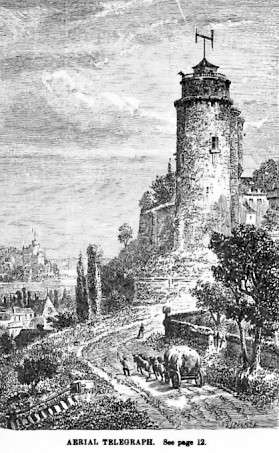
Claude Chappe developed a telegraph system in 1793 from Paris to Lille.
These purpose-built stone towers with Chappe's two signal arms on top came later.
The next tower in the relay is just across the river over there.
Telescopes assisted in viewing the 'distant writing' of the signals.
France retained this proven system for some time after the electromagnetic telegraph became available.
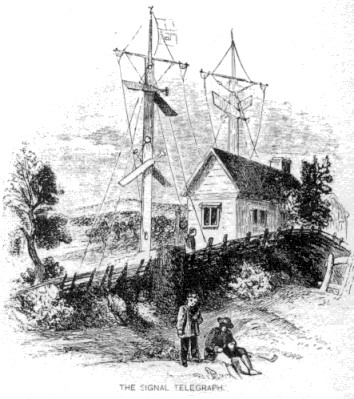 A telegraph system designed by someone else ...
A telegraph system designed by someone else ...
The British Admiralty had a set.
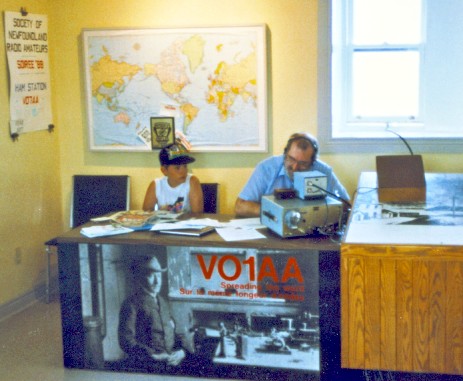
At 2030hr on warm and humid July 7, 1988 at the Cabot Tower on Signal Hill, St. John's, Newfoundland ...
the demonstration Ham Radio station is pulling in the Ukraine.
Marconi's image reminds us of the historic wireless transmissions from Signal Hill.
Minutes later, a guy with a square-headed management hair-do shows us how Signal Hill was actually named ...
Make a note of the approaching sea traffic on the seaward side ...
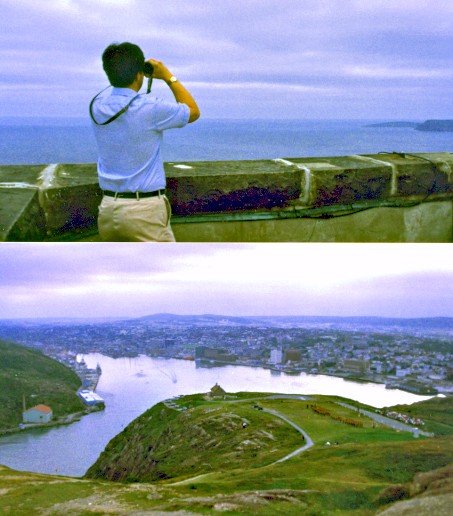 ... and cross to the harbour side of the tower.
... and cross to the harbour side of the tower.
Signal to the red-coated garrison on the field below and to the settlement if there is any news.
For example: expected commercial traffic or unexpected enemy warships.
Telegraph Hill in San Francisco (and many others) were named for manual telegraphy ...
long before wireless telegraphy took over the high ground.
Consider some of the independent and published discoveries which made the telegraph possible ...
Developing a sustained source of electric power ...
that is, beyond static electricity.
Allesandro Volta (Italy, 1745-1827)
- Used chemical action to produce galvanic currents in 1800.
- Used zinc, copper and an electrolyte to make cells and batteries.
Volta explains to Napoleon that it is possible to create a steady current.
' ... it is like a little windup bunny with a drum ...'
Understanding electrical circuits.
Georg Simon Ohm (Germany, 1789-1854)
-
Investigated electric circuits and developed Ohm's Law (1827) ...
-
This explains the relationship between current flow, voltage 'pressure' and circuit resistance within an electric circuit.
-
e.g. Current = Voltage divided by Resistance ... in the appropriate units of course
Hans Christian Oersted (Denmark 1777-1851)
That retro-styled cone-shaped vessel is his battery.
Oersted noticed that a compass needle was deflected by a nearby electric circuit ...
so ... the current is surrounded by a magnetic field.
It looks as if he bought his wires and stuff at Radio Shack ... or Circuit City.
Developing electromagnets.
William Sturgeon (England, 1783-1850)
Andre-Marie Ampere (France, 1775-1836)
Joseph Henry (USA, 1797-1878)
- Sturgeon wound bare wire around a core and ran current through it to produce a magnet in 1824.
- It was discovered that soft iron was ideal to form the core of a powerful electromagnet.
- Ampere developed a mathematical equation which predicted some electromagnetic phenomena yet to be discovered.
- Henry used many windings of fine insulated wire around a core - later essential for the telegraph.
- Using this technique Henry created a magnet which was able to lift one ton.
 In the early 1830s Henry noticed that moving a bar-shaped magnet
near a closed loop of wire ... could produce current in the latter (top).
In the early 1830s Henry noticed that moving a bar-shaped magnet
near a closed loop of wire ... could produce current in the latter (top).
At the same time, unknown to Henry, Faraday was doing the same type of work in Britain.
Faraday published first in 1832.
1. Moving the little energized coil relative to the big coil ... moves the specially mounted galvanometer needle (left).
2. But energizing and de-energizing the little coil when it is stationary ... also moves the galvanometer needle.
What the ... ?
When magnetic forces (i.e. their lines of flux) change relative to a wire, they induce a current.
That's what 1 and 2 have in common.
Henry was an modest man of science who contributed to diverse scientific endeavours later in life.
Henry's experiments also allowed him to note the 'transforming' of electrical current ...
i.e. varying the final current and voltage by using different sized secondary coils.
Joseph Henry always regretted not being recognized for his original
unpublished discoveries ... which had actually just preceded Faraday's.
(Henry
also probably kicked himself for never getting a piece of the
remunerative cellphone battery recharger transformer market)
Henry also encouraged and coached Morse and Bell when they came to him for help with the inventions.
The both needed small, strong magnetic coils for their devices.
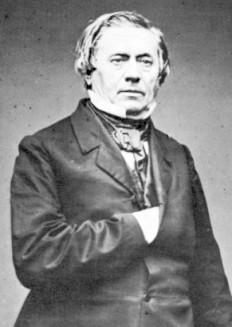 Joseph Henry
Joseph Henry
Morse's Telegraph
Below are a couple of illustrations of devices based on Morse's patents.
The spring-return telegraph key is quite typical ... from an 1860 publication from Britain.
The operator depressed it to make the electrical contact at the arrow.
This is given as an example of a 'Morse patent' which had already been invented.
Morse's receiving 'sounder' or 'register' was actually an inkless tape inscriber ...
The electromagnets (right) clicked as they responded to the distant telegraph message.
There was a winding key for the clockwork tape-regulating mechanism (at the left).
The clockwork mechanism drew a paper tape through the tape rollers near the inscribing stylus.
There, the stylus, driven by the electromagnets, recorded the official message - pressed into the moving tape in code.
The clockwork regulated 'tape feed' had to be started manually when a message was to be received,
and a weight hanging below (see the suspending cord at the lower left) provided the main pulling force for the whole operation.
Was this type of device actually used on North American railways?
The Grand Trunk Railway of Canada
Rules and Regulations
for Operators and Station Masters
working the
Telegraph Lines, 1855
state:
39. Registers must be kept clean and always in good running order.
47. The register paper must not be allowed to run unnecessarily,
and the lines must be run as closely as possible to prevent waste. [closely = efficiently]
51. The originals of all messages must be neatly filed each day,
with the date written on the band; and be preserved in the office from
which they are transmitted.
19. The taking of messages by sound alone is prohibited. In all
cases, the register paper must be allowed to run, and the communication
when copied, compared therewith. The receiving Operator will be held
responsible for errors, unless, by producing the register paper, he can show that the blame rests with the transmitting Operator.
[Rule 19 ... emphasis as indicated in the rulebook]
Telegraphic Code
'Apples and Oranges'
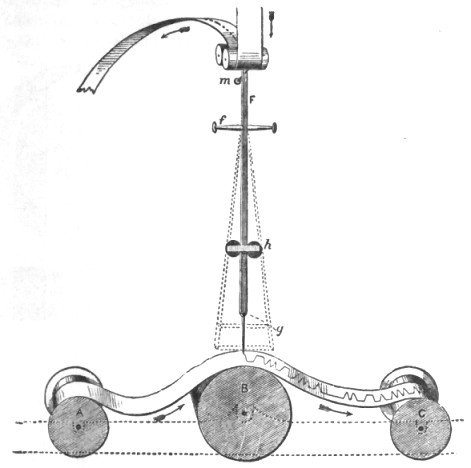 As originally conceived circa 1837, the received message was
to be printed or inscribed as a graph of the electric impulses (lower).
As originally conceived circa 1837, the received message was
to be printed or inscribed as a graph of the electric impulses (lower).
This schematic drawing is intended to contrast the two Morse methods of recording messages on moving paper tape.
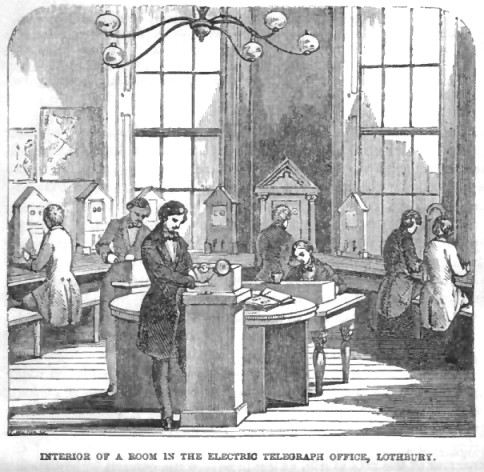 In Britain there was no interest in patenting Morse's equipment or code.
In Britain there was no interest in patenting Morse's equipment or code.
Germany was the only major European country to show a moderate interest Morse's ideas.
Above, circa 1855, the 'agents' are working at their Double Needle Telegraphs.
Signals were perceived at the receiver by staring at the the deflections of a glorified galvanometer needle.
Each character was differentiated by ... combinations of left or right
deflections ... and short or long periods for these deflections.
Both the British and French preferred their own local technologies and code to what Morse had developed.
Earlier versions of these British 'Wheatstone and Cooke' Needle Telegraphs had 5 needles,
but primitive underground wire insulating techniques, combined with the need to maintain 6* underground wires ...
forced changes after the first pilot projects.
*(6 wires because they didn't yet know Steinheil had discovered the 'earth return')
Eventually, bare wire strung from poles between stations with an earth 'ground' proved much more efficient.
With grounding to earth ... only a SINGLE wire was finally needed between many moderately busy telegraph stations
for Morse-style equipment.
* * *
Perhaps more than is warranted, the following passage of the period exalts
the homing abilities of the Refined Victorian electrons, once the signal reaches its destination ...
as the line potential equalizes into the buried 'ground return' plate at the destination.
" Of all the miracles
of science, surely this is the most marvelous. A stream of electric
fluid has its source in the cellars of the Central Electric Telegraphic
Office, Lothbury, London. It flows under the streets of the great
metropolis, and, passing on wires suspended over a zigzag series of
railways, reaches Edinburgh, where it dips into the earth, and diffuses
itself upon the buried plate. From that it takes flight through the
crust of the earth, and finds its own way back to the cellars at
Lothbury !!! "
Wonders of Science, 1860






